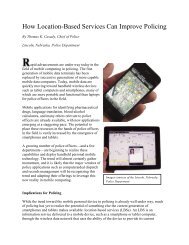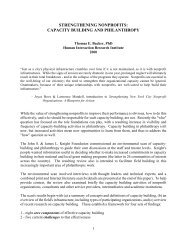Documentation of Violence Risk Information in Psychiatric Hospital ...
Documentation of Violence Risk Information in Psychiatric Hospital ...
Documentation of Violence Risk Information in Psychiatric Hospital ...
You also want an ePaper? Increase the reach of your titles
YUMPU automatically turns print PDFs into web optimized ePapers that Google loves.
Good Samaritan <strong>Hospital</strong> and Health Center additionally<br />
stated that dangerousness assessments must<br />
be made “<strong>in</strong> light <strong>of</strong> the present day scientific knowledge<br />
<strong>in</strong> that specialty.” 15 Commentators have noted<br />
and analyzed several legal cases <strong>in</strong> which the courts<br />
discuss the relevance and importance <strong>of</strong> psychiatrists’<br />
and other mental health pr<strong>of</strong>essionals’ obta<strong>in</strong><strong>in</strong>g and<br />
document<strong>in</strong>g certa<strong>in</strong> types <strong>of</strong> risk <strong>in</strong>formation when<br />
assess<strong>in</strong>g dangerousness. 10,12<br />
In addition to liability concerns, proper documentation<br />
is also necessary for proper risk management:<br />
“The quality <strong>of</strong> any [violence risk assessment] decision<br />
can only be as good as the <strong>in</strong>formation on which<br />
it is based. ...” 6 Commentators have noted that documentation<br />
<strong>of</strong> critical risk data is key to optimiz<strong>in</strong>g<br />
prediction and management <strong>of</strong> violence <strong>in</strong> psychiatric<br />
and forensic sett<strong>in</strong>gs. 16 Recently, researchers<br />
demonstrated that a s<strong>in</strong>gle tra<strong>in</strong><strong>in</strong>g session with cl<strong>in</strong>ical<br />
staff leads to significant improvement <strong>in</strong> risk<strong>of</strong>-violence<br />
documentation with no extra time, resources,<br />
or paperwork and with true multidiscipl<strong>in</strong>ary<br />
<strong>in</strong>volvement. 17 Similarly, exam<strong>in</strong><strong>in</strong>g documentation<br />
is a necessary part <strong>of</strong> implement<strong>in</strong>g <strong>of</strong><br />
state-<strong>of</strong>-the-art violence risk assessment tools that<br />
have emerged <strong>in</strong> the past decade. Adm<strong>in</strong>istration <strong>of</strong><br />
<strong>in</strong>struments such as the Psychopathy Checklist<br />
(PCL) 18 and the <strong>Violence</strong> <strong>Risk</strong> Appraisal Guide<br />
(VRAG) 6 depend <strong>in</strong> part on access to detailed case<br />
history <strong>in</strong>formation <strong>in</strong>clud<strong>in</strong>g but not limited to<br />
crim<strong>in</strong>al history, diagnosis, history <strong>of</strong> violence, and<br />
course <strong>of</strong> hospitalization. Thus, newly developed risk<br />
assessment measures require thorough documentation<br />
<strong>of</strong> risk <strong>in</strong>formation.<br />
However, little is known about how <strong>in</strong>formation<br />
regard<strong>in</strong>g the risk <strong>of</strong> violence is documented <strong>in</strong> actual<br />
cl<strong>in</strong>ical practice. With respect to suicide risk management,<br />
Malone et al. 19 found that history <strong>of</strong> suicide<br />
was <strong>of</strong>ten not documented for suicidal patients and<br />
that patient characteristics, such as presence <strong>of</strong> personality<br />
disorder, <strong>in</strong>fluenced documentation <strong>of</strong> risk<br />
factors for suicidal behavior. Do the patient’s characteristics<br />
<strong>in</strong>fluence documentation <strong>of</strong> violence risk<br />
<strong>in</strong>formation <strong>in</strong> a correspond<strong>in</strong>g manner? If so, what<br />
patient variables seem to affect documentation practices,<br />
and <strong>in</strong> what ways? Institutional sett<strong>in</strong>g may also<br />
affect documentation for assessment <strong>of</strong> violence<br />
risk. 9 If this is the case, how might <strong>in</strong>stitutional sett<strong>in</strong>g<br />
affect documentation <strong>of</strong> violence risk <strong>in</strong>formation?<br />
Are cl<strong>in</strong>icians document<strong>in</strong>g risk data systematically<br />
across different sett<strong>in</strong>gs? The purpose <strong>of</strong> this<br />
Elbogen, Tomk<strong>in</strong>s, Pothuloori, et al.<br />
study was to resolve these questions and to <strong>in</strong>vestigate<br />
empirically the cl<strong>in</strong>ical documentation <strong>of</strong> <strong>in</strong>formation<br />
related to risk <strong>of</strong> violence <strong>in</strong> psychiatric<br />
sett<strong>in</strong>gs.<br />
Methods<br />
Volume 31, Number 1, 2003<br />
Sett<strong>in</strong>g<br />
This study was conducted <strong>in</strong> L<strong>in</strong>coln, Nebraska<br />
(population 250,000), and <strong>in</strong>volved four <strong>in</strong>patient<br />
psychiatric sett<strong>in</strong>gs: acute, chronic, crisis, and forensic.<br />
The acute, chronic, and forensic hospitals are<br />
located <strong>in</strong> a 240-bed, state-operated psychiatric facility<br />
that serves most <strong>of</strong> the severely mentally ill patients<br />
<strong>in</strong> Nebraska and surround<strong>in</strong>g states. Half <strong>of</strong><br />
the facility’s beds are housed <strong>in</strong> the forensic hospital<br />
where evaluation and treatment services are provided<br />
for adults found Not Responsible by Reason <strong>of</strong> Insanity<br />
and Incompetent to Stand Trial as well as civilly<br />
committed sex <strong>of</strong>fenders. Nonforensic adult patients<br />
who are civilly committed are first stabilized <strong>in</strong><br />
the 40-bed acute-care hospital (average length <strong>of</strong><br />
stay, 68 days). Those nonforensic adult patients who<br />
need more <strong>in</strong>tensive care are treated at the 40-bed<br />
chronic care hospital, which <strong>of</strong>fers extensive psychosocial<br />
rehabilitation for long-term patients. The<br />
county crisis center is located with<strong>in</strong> the local community<br />
mental health center and is a 15-bed facility<br />
that serves as the <strong>in</strong>itial gateway for longer-term <strong>in</strong>patient<br />
mental health services. Patients at risk to<br />
harm themselves or others are brought to the crisis<br />
center for evaluation <strong>of</strong> the appropriateness <strong>of</strong> civil<br />
commitment. The crisis center receives more than 50<br />
admissions per month, with an average length <strong>of</strong> stay<br />
<strong>of</strong> 12 days. Patients are discharged to the community<br />
or transferred to other <strong>in</strong>patient facilities, typically<br />
the state hospital.<br />
For statistical analysis, each facility was categorized<br />
by location, type <strong>of</strong> population, and patient<br />
legal status at admission. With respect to location,<br />
each facility was labeled as either a crisis or state<br />
hospital facility. Type <strong>of</strong> population was characterized<br />
as either acute (def<strong>in</strong>ed as average length <strong>of</strong> stay<br />
less than three months) or chronic (more than three<br />
months’ average length <strong>of</strong> stay). By such def<strong>in</strong>itions,<br />
the crisis center and acute unit were def<strong>in</strong>ed as acute<br />
whereas the chronic and forensic units were considered<br />
chronic. F<strong>in</strong>ally, legal status designat<strong>in</strong>g type <strong>of</strong><br />
commitment was divided <strong>in</strong>to civil and crim<strong>in</strong>al. All<br />
59

















